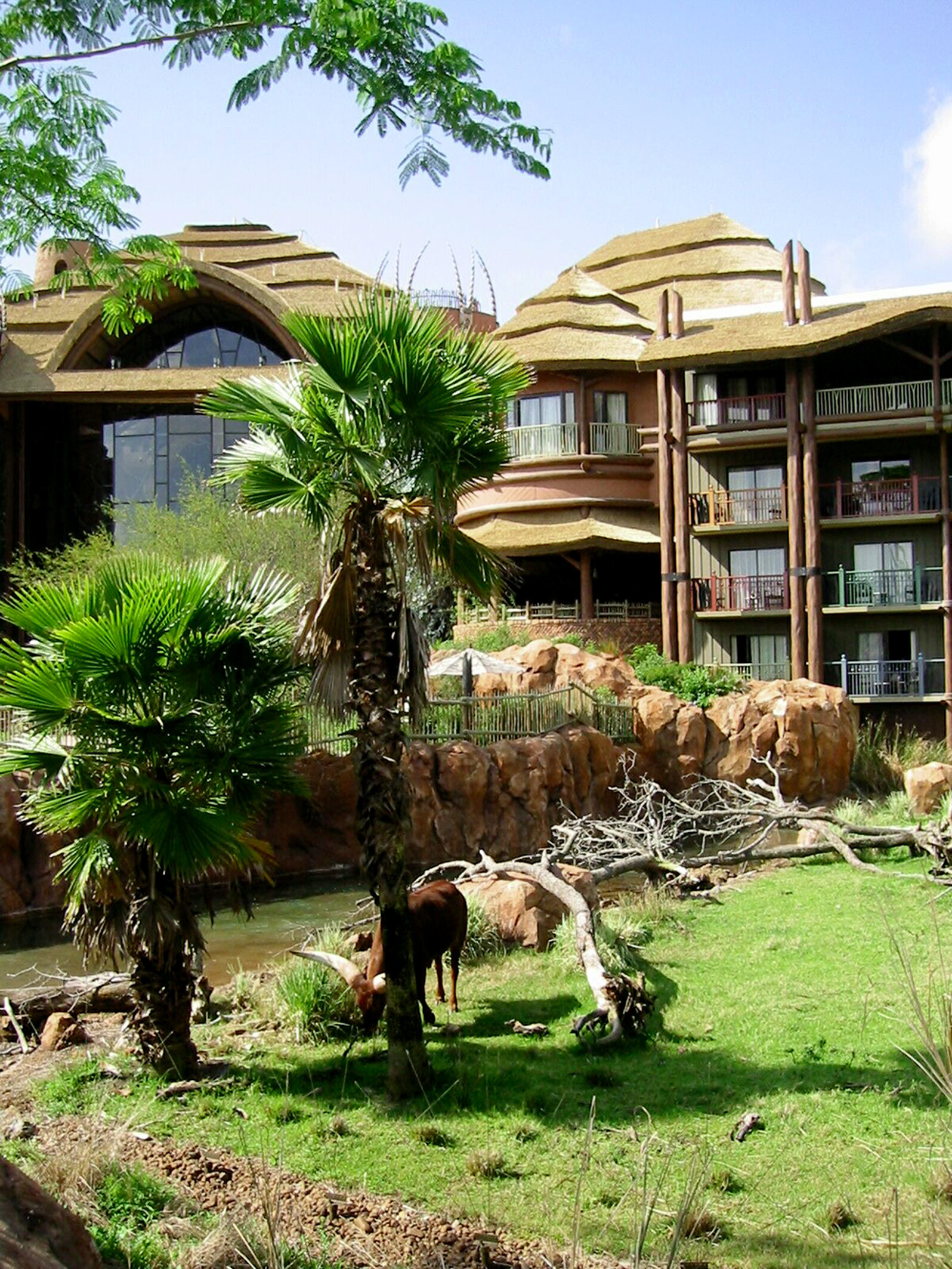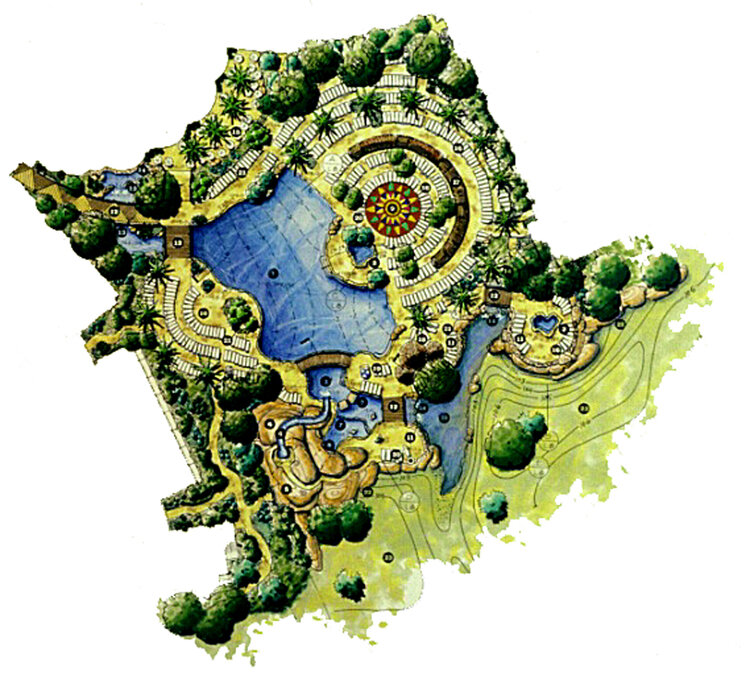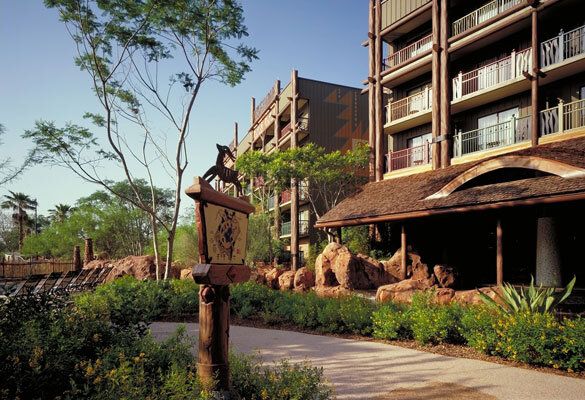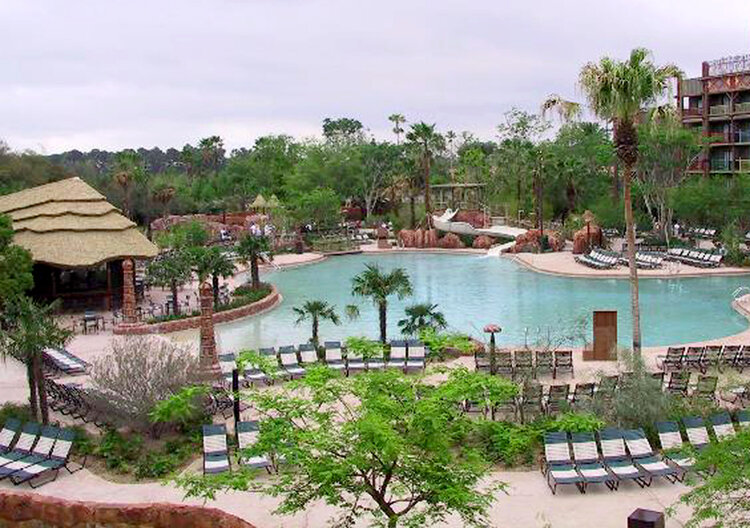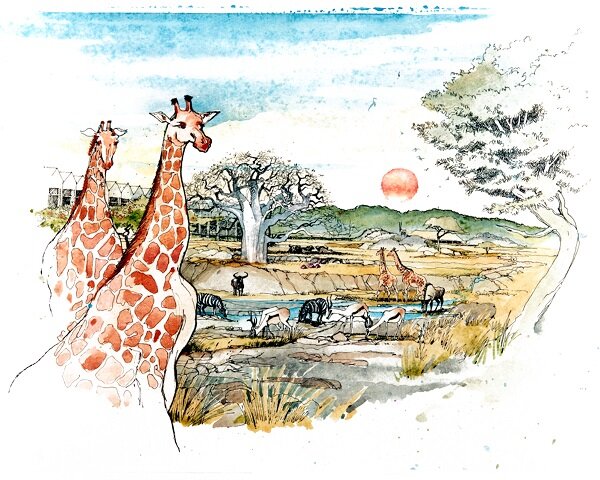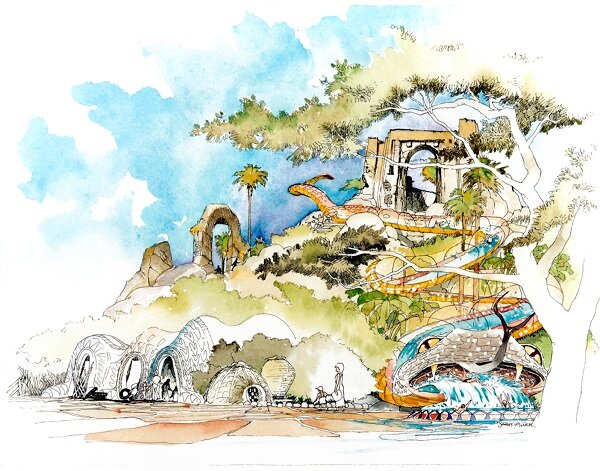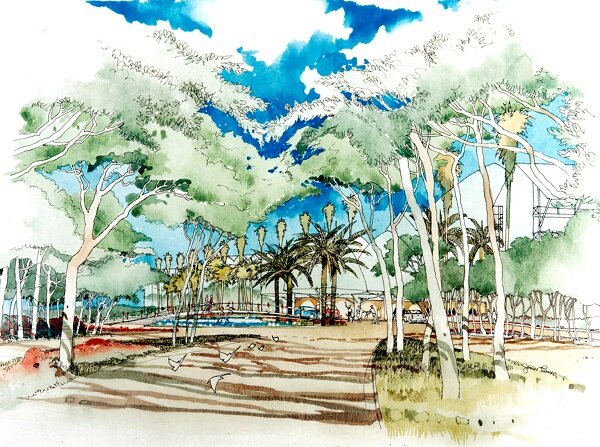Landscape Design of Disney’s Animal Kingdom Lodge
Article written by Chuck Mirarchi for DIS, a fan based website and blog on all things Disney. the site is “The Largest Unofficial Online Guide to Disney” and can be found at wdwinfo.com.
Herbert-Halback, Inc., a landscape architecture firm in Orlando, Florida, was responsible for the design, site development, and landscape architecture at Disney’s Animal Kingdom Lodge Resort. Leading this project was Frederick “Fred” Halback, Co-Founder and Senior Principal of Herbert-Halback. Today the firm is known as Marquis Latimer + Halback, Inc., in St. Augustine, Florida. The firm got the assignment to work on the Animal Kingdom Lodge because of their previous design work on the Swan and the Dolphin Hotels. “The Swan and the Dolphin were designed by Michael Graves,” said Halback, “and it’s the first hotel project that Disney did when Michael Eisner took over. When Michael Eisner came in, he wanted to make the resort development properties more oriented toward what I would call ‘coffee table architects’ versus ‘vanilla’ architecture.”
After designing the Swan and Dolphin Hotels, Fred Halback went on to design Disney’s All-Star Resorts, the Wide World of Sports Complex, and a variety of Disney-related projects. They already had a good track record with Disney.
“I had a relationship with a number of the project and development managers from Disney Development side,” said Halback. “I had heard from a gentleman I had known from working on a previous project that they [Disney] were thinking of doing a hotel around an African theme to go along with the Animal Kingdom Theme Park. I immediately told him about a trip I had just made to Africa a couple of years earlier. I also had a wonderful resource book of all kinds of African safari and lodging pictures and they used it internally as they were gaining more momentum towards doing this project.”
The firm was one of the first — if not the first — consultant hired for the Animal Kingdom Lodge project. “We were hired, along with the architect [Peter Dominick], to begin to develop and nurture the imagery, site design, and other components of the project,” said Halback. “It was exciting to be able to be on the ground floor of the development. It helped us to nurture the theme and the culture of what the project was going to be. If you’ve ever been to Africa, it really is about that unique theme and landscape as a wild place — as a place that is especially interesting at dusk or dawn.”
When the project finally got the green light, Fred Halback was in the right place at the right time.
Having been to Africa and on safaris a couple of times, this job was a dream come true for Halback. “Peter Dominick [the architect] was the same way,” said Halback. “He had been there [Africa] and he really led the team as it related to the design of everything. He was also a great guy to work with. He got what we were wanting to do, which was to recreate those experiences of what Africa is.”
“Combining the Art of African Craftsman with wild game viewing, storytelling around the campfire, and the simplicity of a tented camp, the Animal Kingdom Lodge will be designed to evoke the profound adventure of the epic of life”
They created an Area Development Design Intent Booklet that was a blueprint or manual in describing and guiding the overall design of the resort. The design statement for the resort is as follows:
Safari means “journey” in Swahili and no other Hotel experience can surpass thejourney of Disney’s Animal Kingdom Lodge. Situated adjacent to Disney’s AnimalKingdom Lodge, in a savannah-like game park, this luxurious 1300 room lodge will capture the spirit of adventure, of the exotic, of the unknown romantic Africa.
Combining the Art of African Craftsman with wild game viewing, storytelling around the campfire, and the simplicity of a tented camp, the Animal Kingdom Lodge will be designed to evoke the profound adventure of the epic of life… dawn, dusk, the edge of light, an elegant journey, to the pristine wilderness, ancient civilizations and vast landscapes.
Although challenges can present themselves with any landscaping project, the relatively flat Florida ground was more of a help than a hindrance. “When one first thinks about Africa — Florida — Africa — Florida, how are we going to make those two things somewhat seamless? Actually they were very similar in a lot of ways,” said Halback. “We did not assist Disney in determining which piece of property they were going to put this facility on as they already knew where they were going to put it — towards the edge of Animal Kingdom Park, at the end of a parkway that came through.”
Interestingly, where the resort now sits originally there was a large retention pond. Halback said that in fact it was a very large, deep pond. “They had used this retention pond to build some of the roadways around the park,” said Halback. In order for this project to start, the pond had to be filled in. “Once they filled in the pond and created an appropriate environment, the other thing they did, and was really nice, was this particular piece of property was a dry piece of property. Even though there was a retention pond, there wasn’t any swamp land like you have in Florida and around Disney itself.”
Halback said that this type of land was “extremely important for the health and the care of the animals because most of the kinds of animals that were suitable for viewing at this kind of facility were hoofed animals.” This was important because the drier the ground is, the easier it is to deal with the animal husbandry aspect of Animal Kingdom.
This piece of land was perfect for the building of Animal Kingdom Lodge. “It lent itself to making it easier to recreate the imagery of these places that we wanted to interpret.” The flatness of the land helped because it was exactly what people envision when they think of an African savannah and “candidly, it also made it easier for us because it allowed us to manipulate the grade where we wanted you to have a different experience,” said Halback. This area of the Animal Kingdom complex was very different from where the Animal Kingdom theme park was built. “Animal Kingdom theme park was basically bulldozed and recreated,” said Halback. “Here [Animal Kingdom Lodge] we did work with some of the existing landscape, the backdrop of surrounding landscapes, etcetera.”
Another asset this location provided was that the landscape was very dense and behind it was a wetland. “That backdrop was always very important to us,” said Halback. “It allowed us to create a lot of visual interests as the middle ground and foreground.” In addition to this parcel of land being dry and flat, there were an abundance of scrub oak trees scattered around. “There were a lot of reasonably-sized oak trees that allowed us to trim them up and recreate an African savannah,” said Halback. “Florida scrub oak really does look like a variety of different kinds of African trees, especially when they are trimmed up and gnarly looking. They look like they were blown over by the wind, chewed on by the giraffes and other animals, so they tend to be skinny with a little tuft at the top.”
“Florida scrub oak really does look like a variety of different kinds of African trees, especially when they are trimmed up and gnarly looking. They look like they were blown over by the wind, chewed on by the giraffes and other animals, so they tend to be skinny with a little tuft at the top.”
It wasn’t enough that the physical design of the Animal Kingdom Lodge had to look like a structure out of Africa, the grounds surrounding the lodge had to faithfully replicate an African savannah. Halback and his team had to interpret three kinds of landscaped environments in order to fully immerse the guests. These environs are elevated rock-outcropping areas, the savannah or grasslands, and a riverine system.
The elevated area was achieved by the Animal Kingdom Lodge itself. “Think of this as a slightly more elevated rock outcropping that you would mythically or think of seeing in Africa. I don’t mean the mountains of Mount Kenya, but rock outcroppings or kopje,” said Halback. “This made sense because they used the fill that they were using to close in the retention pond and bringing in to the site to build up where the hotel was going to be. It naturally made a place for us to create the idea of the rock kopje.” In regards to the savannah, “Most people think of flat lands and scattered trees,” said Halback. “This is so memorable of the landscape and the imagery of Africa.” The riverine system is a system or an area where “there is a wellspring or a small stream that came through. These are always what is in people’s minds whenever they think of Africa,” said Halback, “because that is where one sees the animals go to drink.”
Halback said that Peter Dominick created a backstory about what the Animal Kingdom Lodge was and that his story really helped them interpret its design and feel. He said that the Animal Kingdom Lodge was this great encampment that a Swahili king left his son. The son continued to develop this encampment and because this family was strong and important, the encampment was on a rock kopje so they could easily defend themselves in case of attack. There was also a spring on the encampment.
“The notion of a story line was always important to us,” said Halback, “because having been brought up professionally doing Disney work it was always about the story line. The story was that Animal Kingdom Lodge was a small, intimate lodge, but we’d mutter under our breath ‘of 1,300 rooms.’ ”
Because of what they had already done at Animal Kingdom, Disney Imagineers — such as Joe Rhode, Paul Comstock, and others — already had an extensive knowledge of plants that they were looking for. They really helped Halback and his team in identifying the various types of plants and flowers that were to be planted at the resort.
“What we wanted to do — where ever possible — was to use materials that were native to Africa or at least gave you the feel of something that was in Africa,” said Halback. “We used an extensive plant list, some that I was not familiar with but a lot of the Disney folks were. We spent a lot of time gathering those materials. Many of the materials they [Disney] already had — not on that site, but at their nursery. These were materials that were leftover or were being utilized at the Animal Kingdom park. If it wasn’t authentic it was authentic looking, and that was extremely important.”
Halback and his team benefited greatly from the fact that the Animal Kingdom park was up and running for a couple of years now. Not only did they have access to ready-to-use plant materials, but they also learned from Disney’s past mistakes. It also made Halback’s job a bit easier, as Disney already had sources to find materials that they needed.
Starting the project in April 1998, Halback and his team did a lot of advanced growing and a lot of advanced collection of planting materials. “We spent a lot of time and the Disney horticulturalists and landscape architects spent even more time searching out the right plant materials because they already did Animal Kingdom theme park,” said Halback. “They knew where to go if they didn’t already have it on hand. We also moved a lot of big trees in. There were some really large, mature live oaks on the other side of the retention pond. We moved those 20, 30, or 40 of these pretty darn big trees. It was quite the effort.”
“The notion of the plant material was to recreate those three basic landscape experiences,” said Halback. “We were always trying interpret elevated rock-outcropping areas, the savannah or grasslands, and a riverine system,” said Halback.
Selecting and approving the various plant materials for the Animal Kingdom Lodge was a team effort. Disney horticulturists, and in particular Paul Comstock, were very helpful to Halback and his team. In addition, Halback did extensive research into plant material and suggested an exhaustive list of trees, plants, shrubs, grasses, and flowers that they interpreted from the story lines what Disney and Peter Dominick and the team from 4240 Architecture wanted. “We very much tried to match up those story lines with the experience you would have with the landscape,” said Halback.
“Although Disney was building a hotel for people to stay in we really felt — and they [Disney] encouraged us to feel this way — that the landscape was maybe more important than the buildings themselves. The reason for that was because it was the landscape that tied together the imagery, the mythical nature of Africa, the notion of dawn and dusk, the edges of light, and the idea of a place of wildness.”
Halback also spent a lot of time with Disney to understand which landscape pieces would be in the animal habit areas and which would not. “This was important because they needed to ensure that whatever plant materials were in the animal habitats were safe and would not be detrimental to the animals,” said Halback. “We realized that no matter how much they were being fed by artificial means — by feeders and other ways they fed the animals — in essence the landscape we were going to create in the animal habit areas was nothing more than a big salad bar for animals. They were going to eat our materials, they were going to digest it, they were going to walk to another area and poop it out and it would sprout up and the cycle would keep repeating itself.”
In addition to the aesthetic landscaping, Halback created landscaping that had a functional purpose, like shielding back-of-the-house areas and activities and creating entry experiences.
Determining what plants to use somewhat relied on the types of animals that were going to be in the habitats. Not only did Halback and his team need to identify plant materials that were safe for the animals, but also find plants that animals would not eat. Halback said that they worked with Disney’s habitat people and there was a list of animals that would be appropriate to use. “Obviously they didn’t want to use any animals that they felt were dangerous or threatening to guests,” said Halback. “They wanted animals that were friendly and non-threatening to the other animals. They asked us what we thought, but they basically already had the list of animals they wanted.”
“...The landscape we were going to create in the animal habit areas was nothing more than a big salad bar for animals. They were going to eat our materials, they were going to digest it, they were going to walk to another area and poop it out and it would sprout up and the cycle would keep repeating itself.””
Disney has always been about setting up the experience long before guests actually arrived at their destination, and the resort hotels were no different. When arriving at a Disney Resort hotel, the guest’s experience starts long before they arrive at the front door. Typically this immersion begins with intricately themed and landscaped entrances.
“Well before guests arrived at the lodge, we wanted to create a feel of coming in this boulevard and it would be totally wild looking,” said Halback. “Once you pass that zone and you’re coming into the resort complex area the roadways are heavily landscaped. This roadway is somewhat different from the other areas at Disney. It really does funnel you into this landscaped experience, and twenty years later it really feels that way.”
Halback and his team did this for a very specific reason — they wanted guests to forget about all the other things that they had seen and experienced at Walt Disney World. They wanted to immerse guests in to that “sense of arrival and that sense of completely coming into an alien land than any of the other areas guests had seen on property.”
“We didn’t want guests to see the main building at all when they came in,” said Halback. “We wanted it to be an experience that unraveled before them. Our goal, when guests came up the driveway, was to decompress from all the wild things they had previously seen and be made aware that you were coming into the special landscaped environment.”
As guests begin their final approach to the Animal Kingdom Lodge, the roadway is actually climbing up to the porte-cochere and then the lodge reveals itself. “Along the way we began to introduce unique features of African elements,” said Halback. “For example, having been to Africa before this is an experience I can relate to, the entry drive up to the porte-cochere you would see these little campfires that were the lights along the road. We designed a lighting feature that would simulate these campfires using steel rebar that would simulate the little teepee nature that would be the sticks of the fire and lights that would flicker to simulate the campfire. There were no big overhead lights, since they would not be found in Africa, but smaller ground lights that would lead guests to the lodge.”
“As guests arrived at the main entrance of the lodge, only then does the whole building unveil itself. It helped in our mind to begin to create this story line that this lodge was something that had grown over time and this indeed belonged to a very successful Swahili family.”
“As guests arrived at the main entrance of the lodge, only then does the whole building unveil itself. It helped in our mind to begin to create this story line that this lodge was something that had grown over time and this indeed belonged to a very successful Swahili family.”
Pulling from one of Halback’s three interpreted environments, the riverine is represented inside the hotel — in particular in and around the restaurants — through various forms of water features. Starting on the lobby level and heading down the staircase to Boma and Jiko are water features that flow out of rocks and head down to a pool of water below. “We very much wanted to pick up on that notion the reason why the lodge was located where it was because it was the source of the wellspring — water bubbling up out of a rock,” said Halback.
“We architects had the water going through the restaurant — which the restaurant designers loved — then out to the pool area as a stream and a riverine system that ends in a pool of water.” Halback said that guests could imagine this is where the animals could be drinking. “Although we don’t have animals in the pool. we certainly have animal viewing areas that are right next to the pool. You can stand in certain areas around the pool and look down into an area where there would be animals and then turn 90 degrees and look back across the pool area and have that experience.” This was carefully thought out to connect the guest experience to the African experience. It was designed to give the feeling of respite, safety, and transition. “We wanted to seamlessly connect those two things,” said Halback.
As with many modern pools, Animal Kingdom Lodge has zero entry pools. Since there were no steps or steep drops, guests could walk right into the pool just as one would if they were walking into a lake in Africa. Disney also had to include a playground and water slides, but Halback themed them around African art and the African experience. “We worked a lot to make sure they seamlessly fit in and not just a piece of playground material that was just dropped there,” said Halback.
The inspiration for the various rockwork throughout the lodge goes back to Peter Dominick’s backstory that this was the home of a great Swahili king and the best location for his dwelling was someplace up high — some place where he could look out and see for miles around. According to Halback, this place was a “promontory with a large rock kopje that literally comes out of the building itself.” The entire hotel acts like a giant observation platform where you can look out onto the savannah. It also explains why there is a dual sweeping staircase at the opposite end of the lodge. It brings the guests back down to ground level where the savannah and animals are located.
“The thinking behind the placement of the savannahs around the lodge was to present an experience for guests that replicated a safari adventure through the Serengeti in Africa”
Valley Crest Contractors did all the hardscape features, including the paving and rock outcroppings. “Disney Imagineering, who designed a lot of the rock features for the Animal Kingdom Theme Park, came in and were very helpful, very instrumental, and very hands-on making the rock outcropping very authentic.”
Halback was laughing when he said that the plantings they created and installed in the animal habitats 20 years ago probably do not look anything like the original planting design plan, because the animals would have chewed on them or they would have been moved to another area. Halback said he likes that because that is what make it feel real.
Another thing that would have been very apparent if it was done wrong was signage. Although you wouldn’t typically find signs in an actual African village, not having them at a resort was not an option. “Disney’s signage and graphics folks were great at picking up our imagery and hardscape features and interpreting those into signage elements,” said Halback. “In particular some of the artistic motifs of African art, how they would be used on everyday things like water and food containers, pottery, beads and necklaces.”
“The thinking behind the placement of the savannahs around the lodge was to present an experience for guests that replicated a safari adventure through the Serengeti in Africa,” writes Chuck Schmidt, author of Disney’s Animal Kingdom: An Unofficial History They certainly did that in spades
In his book, Schmidt writes that Paul Comstock — Animal Kingdom’s principal landscaper — said, “We used the same palette of plant material that we had generated for the Animal Kingdom theme park. By the time we had built the hotel, we had experimented with and planted 375 different species of grasses alone. What we were looking for was the holy grail of grass plants that the animals did not like to eat … Ultimately, we found about 10 different kinds of grasses.”
Article written for DIS, a fan based website and blog on all things Disney, by Chuck Mirarchi. The site is “The Largest Unofficial Online Guide to Disney” and can be found at wdwinfo.com.

